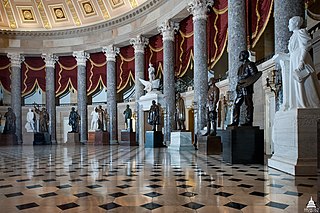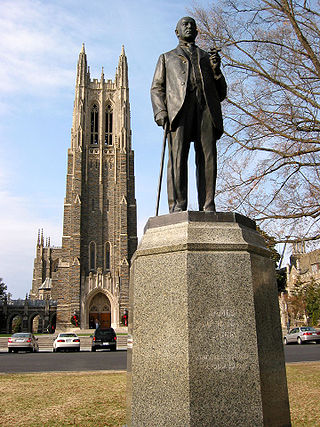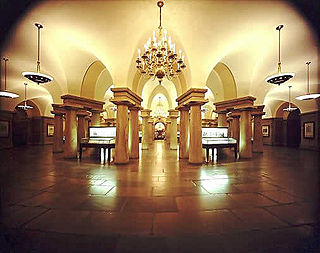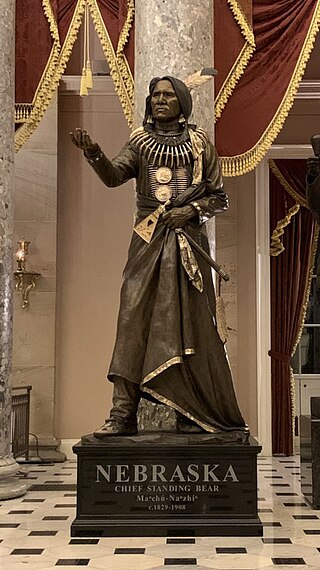
Lee Oscar Lawrie was an American architectural sculptor and an important figure in the American sculpture scene preceding World War II. Over his long career of more than 300 commissions Lawrie's style evolved through Modern Gothic, to Beaux-Arts, Classicism, and, finally, into Moderne or Art Deco.

The National Statuary Hall is a chamber in the United States Capitol devoted to sculptures of prominent Americans. The hall, also known as the Old Hall of the House, is a large, two-story, semicircular room with a second story gallery along the curved perimeter. It is located immediately south of the Rotunda. The meeting place of the U.S. House of Representatives for nearly 50 years (1807–1857), after a few years of disuse it was repurposed as a statuary hall in 1864; this is when the National Statuary Hall Collection was established. By 1933, the collection had outgrown this single room, and a number of statues are placed elsewhere within the Capitol.

The National Statuary Hall Collection in the United States Capitol is composed of statues donated by individual states to honor persons notable in their history. Limited to two statues per state, the collection was originally set up in the old Hall of the House of Representatives, which was then renamed National Statuary Hall. The expanding collection has since been spread throughout the Capitol and its Visitor's Center.

Charles Keck was an American sculptor from New York City, New York.

Standing Bear was a Ponca chief and Native American civil rights leader who successfully argued in U.S. District Court in 1879 in Omaha that Native Americans are "persons within the meaning of the law" and have the right of habeas corpus, thus becoming the first Native American judicially granted civil rights under American law. His first wife Zazette Primeau (Primo), daughter of Lone Chief, mother of Prairie Flower and Bear Shield, was also a signatory on the 1879 writ that initiated the famous court case.
Rudulph Evans was a sculptor.

The United States Capitol building features a central rotunda below the Capitol dome. Built between 1818 and 1824, the rotunda has been described as the Capitol's "symbolic and physical heart".

Franklin Bachelder Simmons was a prominent American sculptor of the nineteenth century. Three of his statues are in the National Statuary Hall Collection, three of his busts are in the United States Senate Vice Presidential Bust Collection, and his statue of Ulysses S. Grant is in the United States Capitol Rotunda.

The United States Capitol crypt is the large circular room filled with forty neoclassical Doric columns directly beneath the United States Capitol rotunda. It was built originally to support the rotunda as well as offer an entrance to Washington's Tomb. It currently serves as a museum and a repository for thirteen statues of the National Statuary Hall Collection.

The Hall of Columns is a more than 100-foot-long (30 m) hallway lined with 28 fluted columns in the south wing extension of the United States Capitol in Washington, D.C. It is also the gallery for 18 statues of the National Statuary Hall Collection.

Benjamin Matthew Victor is an American sculptor living and working in Boise, Idaho. He is the only living artist to have three works in the National Statuary Hall in the United States Capitol. He is currently sculpting his fourth statue for the Statuary Hall, of Daisy Bates. He was only 26 years old when his first statue, Sarah Winnemucca, a Paiute activist in Nevada, was dedicated in the Hall in 2005, making him the youngest artist to ever be represented in the Hall. In 2014, his sculpture of Norman Borlaug, "the father of the Green Revolution," was dedicated in the National Statuary Hall and in 2019, his statue of Chief Standing Bear, a Native American rights leader, was dedicated in the National Statuary Hall making him the only living artist to have three sculptures in the Hall.
Robert E. Lee is a bronze sculpture commemorating the general of the same name by Edward Virginius Valentine, formerly installed in the crypt of the United States Capitol as part of the National Statuary Hall Collection. The statue was given by the commonwealth of Virginia in 1909. On December 21, 2020, the sculpture was removed from the grounds of the United States Capitol and relocated to the Virginia Museum of History & Culture.

Alexander H. Stephens is a marble sculpture commemorating the American politician of the same name by Gutzon Borglum, installed in the United States Capitol as part of the National Statuary Hall Collection. The statue was gifted by the state of Georgia in 1927.

Jefferson Davis, created by Henry Augustus Lukeman, is a bronze sculpture of Jefferson Davis – a U.S. Senator, U.S. Secretary of War, plantation owner and the only President of the Confederate States of America – commissioned by the U.S. State of Mississippi for inclusion in National Statuary Hall Collection at the United States Capitol's National Statuary Hall, in Washington, D.C. The statue was controversial at the time of its unveiling and there have been multiple efforts to remove it from the Capitol since 2015.

The National Statuary Hall Collection holds statues donated by each of the United States, portraying notable persons in the histories of the respective states. Displayed in the National Statuary Hall and other parts of the United States Capitol in Washington, D.C., the collection includes two statues from each state, except for Virginia which currently has one, making a total of 99.

Helen Keller is a bronze sculpture depicting the American author and political activist of the same name by Edward Hlavka, installed in the United States Capitol Visitor Center's Emancipation Hall, in Washington, D.C., as part of the National Statuary Hall Collection. The statue was gifted by the U.S. state of Alabama in 2009, and replaced one depicting Jabez Lamar Monroe Curry, which had been donated in 1908.

Julius Sterling Morton, also known as J. Sterling Morton, is a 1937 bronze sculpture of Julius Sterling Morton by Rudulph Evans, installed in the United States Capitol Visitor Center, in Washington, D.C., as part of the National Statuary Hall Collection. It is one of two statues donated by the state of Nebraska. The sculpture was accepted into the collection by Congressman Karl Stefan of Nebraska on April 27, 1937.
Francis Harrison Pierpont is a 1910 marble sculpture of Francis Harrison Pierpont by Franklin Simmons installed in the United States Capitol, in Washington, D.C., as part of the National Statuary Hall Collection. It is one of two statues donated by the state of West Virginia. The sculpture was unveiled by the Hon. Thomas Condit Miller, on April 27, 1937.

In 2019, the U.S. state of Nebraska donated a bronze sculpture of Standing Bear by Benjamin Victor to the National Statuary Hall Collection. The statue is installed in the United States Capitol's National Statuary Hall, in Washington, D.C.

A statue of Harry S. Truman was installed in the U.S. Capitol, in Washington, D.C., on September 29, 2022, as part of the National Statuary Hall Collection. It replaced the statue of Thomas Hart Benton.
















